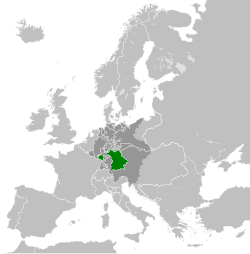Kingdom of Bavaria
| Kingdom of Bavaria | ||||||||||||||
| Königreich Bayern | ||||||||||||||
|
Electorate of the Holy Roman Empire (1805–1806) State of the Confederation of the Rhine (1806–13) State of the German Confederation (1815–66) Federal State of the German Empire (1871–1918) |
||||||||||||||
|
||||||||||||||
|
||||||||||||||
|
Anthem Königsstrophe "Kings stanze" |
||||||||||||||
|
Location of the Kingdom of Bavaria (green) within the German Confederation (dark grey) and Europe, circa 1815
|
||||||||||||||
|
The Kingdom of Bavaria within the German Empire with the exclave of Palatinate
|
||||||||||||||
| Capital | Munich | |||||||||||||
| Languages |
Bavarian, Swabian, Main-Franconian, Rhine-Franconian |
|||||||||||||
| Religion |
Majority: Roman Catholic
Minorities:
|
|||||||||||||
| Government | Constitutional Monarchy | |||||||||||||
| King | ||||||||||||||
| • | 1805–1825 | Maximilian I Joseph | ||||||||||||
| • | 1825–1848 | Ludwig I | ||||||||||||
| • | 1848–1864 | Maximilian II | ||||||||||||
| • | 1864–1886 | Ludwig II | ||||||||||||
| • | 1886–1913 | Otto | ||||||||||||
| • | 1913–1918 | Ludwig III | ||||||||||||
| Prince Regent | ||||||||||||||
| • | 1886–1912 | Leopold Charles | ||||||||||||
| • | 1912–1913 | Ludwig Leopold | ||||||||||||
| Minister-President | ||||||||||||||
| • | 1806–1817 | Maximilian von Montgelas | ||||||||||||
| • | 1917–1918 | Otto Ritter von Dandl | ||||||||||||
| Legislature | Landtag | |||||||||||||
| • | Upper Chamber | Herrenhaus | ||||||||||||
| • | Lower Chamber | Abgeordnetenhaus | ||||||||||||
| Historical era | Napoleonic Wars / WWI | |||||||||||||
| • | Treaty of Pressburg | 26 December 1805 | ||||||||||||
| • | Established | 26 December 1805 | ||||||||||||
| • | Treaty of Ried | 8 October 1813 | ||||||||||||
| • | Treaty of Paris | 30 May 1814 | ||||||||||||
| • | Unification of Germany | 18 January 1871 | ||||||||||||
| • | German Revolution | 9 November 1918 | ||||||||||||
| • | Anif declaration | 12 November 1918 | ||||||||||||
| Area | ||||||||||||||
| • | 1910 | 75,865 km² (29,292 sq mi) | ||||||||||||
| Population | ||||||||||||||
| • | 1910 est. | 6,524,372 | ||||||||||||
| Density | 86 /km² (222.7 /sq mi) | |||||||||||||
| Currency |
Bavarian Gulden, (1806–1873) German Goldmark, (1873–1914) German Papiermark (1914–1918) |
|||||||||||||
|
||||||||||||||
The Kingdom of Bavaria (German: Königreich Bayern) was a German state that succeeded the former Electorate of Bavaria in 1805 and continued to exist until 1918. The Bavarian Elector Maximilian IV Joseph of the House of Wittelsbach became the first King of Bavaria in 1805 as Maximilian I Joseph. The crown would go on being held by the Wittelsbachs until the kingdom came to an end in 1918. Most of Bavaria's present-day borders were established after 1814 with the Treaty of Paris, in which Bavaria ceded Tyrol and Vorarlberg to the Austrian Empire while receiving Aschaffenburg and Würzburg. With the unification of Germany into the German Empire in 1871, the kingdom became a state of the new Empire and was second in size, power, and wealth only to the leading state, the Kingdom of Prussia. Since the end of the kingdom and the empire in 1918, Bavaria has remained part of Germany.
On 30 December 1777, the Bavarian line of the Wittelsbachs became extinct, and the succession on the Electorate of Bavaria passed to Charles Theodore, the Elector Palatine. After a separation of four and a half centuries, the Palatinate, to which the duchies of Jülich and Berg had been added, was thus reunited with Bavaria. In 1792 French revolutionary armies overran the Palatinate; in 1795 the French, under Moreau, invaded Bavaria itself, advanced to Munich—where they were received with joy by the long-suppressed Liberals—and laid siege to Ingolstadt. Charles Theodore, who had done nothing to prevent wars or to resist the invasion, fled to Saxony, leaving a regency, the members of which signed a convention with Moreau, by which he granted an armistice in return for a heavy contribution (7 September 1796). Between the French and the Austrians, Bavaria was now in a bad situation. Before the death of Charles Theodore (16 February 1799) the Austrians had again occupied the country, in preparation for renewing the war with France.
...
Wikipedia




